the place where Paleontology and Paleoanthropology meets Philately
South Georgia and the South Sandwich Islands
Contributors to Paleontology science on stamps of South Georgia and the South Sandwich Islands
| << previous country | back to index | next country >> |
Contents:
- Country overview
- Philately of South Georgia and the South Sandwich Islands
- Some stamps of South Georgia and the South Sandwich Islands to consider
- References
- Acknowledgements
South Georgia and the South Sandwich Islands (SGSSI) is a British Overseas Territory in the southern Atlantic Ocean.
It is a remote and inhospitable collection of islands, consisting of South Georgia and a chain of smaller islands known as the South Sandwich Islands. The territory's total land area is 3,903 km2. The Falkland Islands are about 1,300 kilometres west from its nearest point.
South Georgia became a base for whaling beginning in the 20th century, until whaling ended in the 1960s. With the end of the whaling industry, the stations were abandoned.
Nowadays, there are is no permanent native population living on the South Sandwich islands, and a very small non-permanent population resides on South Georgia.
There are no scheduled passenger flights or ferries to or from the territory, although visits by cruise liners to South Georgia are increasingly popular, with several thousand visitors each summer.The United Kingdom claimed sovereignty over South Georgia in 1775 and the South Sandwich Islands in 1908.
The territory of "South Georgia and the South Sandwich Islands" was formed in 1985; previously, it had been governed as part of the Falkland Islands Dependencies. [R1]
The first post office opened on the South Georgia on 22 December 1909, some two years after the first whaling station had been established at Grytviken.
The first stamps specifically for South Georgia were issued in 1944 and consisted of overprints on stamps of the Falkland Islands for use in South Georgia when it was part of the Falkland Islands Dependencies.
From 1986 stamps of the territory are inscribed "South Georgia & South Sandwich Islands".
Nowadays South Georgia and the South Sandwich Islands continues to issue a dozen new stamps a year.
These stamps are dedicated to collectors as they are not needed for the few people who works on the islands.
The Falklands Post Service (FPS) Company sells these stamps.
FPS Limited was established in July 2014 in time to take over the management of the post and philatelic service on behalf of the Falkland Islands Government on the 1st August 2014.
The key function of their Philatelic service is the marketing and sales of Falkland Islands stamps as well as stamps of South Georgia and the South Sandwich Islands and British Antarctic Territory. [R2]
Some stamps of South Georgia and the South Sandwich Islands to consider: contributors to Paleontology science
| 10.12.2004 "100th anniversary of Grytviken's founding" [3] | 15.03.2011 "155th anniversary of Sir Alister Clavering Hardy" [1] | 25.11.2011 "Polar Explorers" [2] |
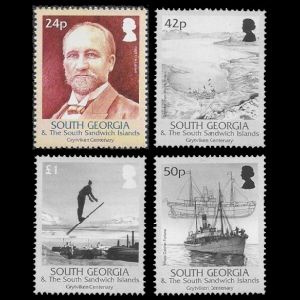 |
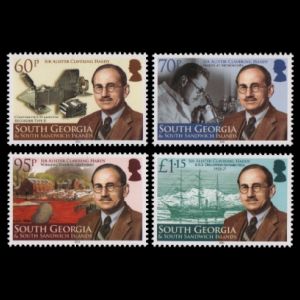 |
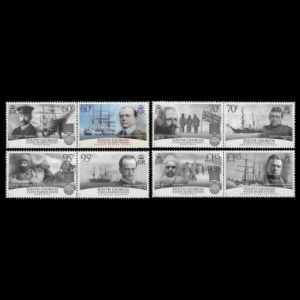 |
| 24.12.2013 "100th anniversary of Norwegian Lutheran Church of Grytviken" [3] | 05.11.2015 Definitive set "Personalities and Ships" [1] | 15.08.2019 "Medicinal Foods" [3] |
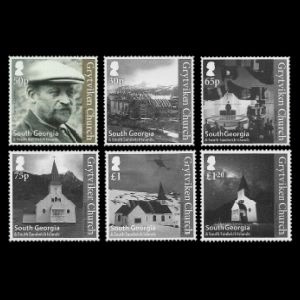 |
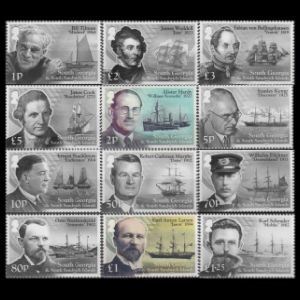 |
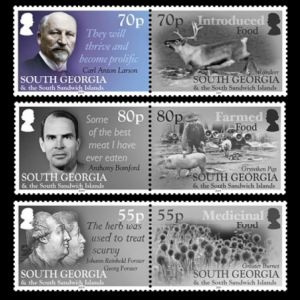 |
Notes:
[1] Sir Alister Clavering Hardy (10 February 1896 – 22 May 1985) was an English marine biologist, an expert on marine ecosystems spanning organisms from zooplankton to whales.
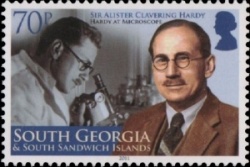
|
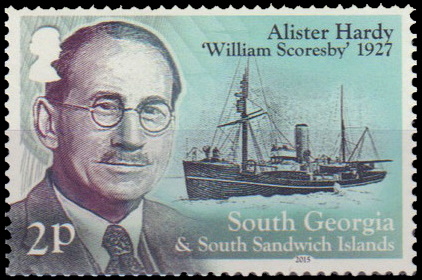
|
| Sir Alister Clavering Hardy on stamps of South Georgia and the South Sandwich Islands 2011 (MiNr.: 526, Scott: 423) and 2015 (MiNr.: 640, Scott: 519) | |
In 1960 he published a hypothesis that assumes that in the evolution of man the ancestors of man from the present time lived intensively in water for a long period of time. He argued that a branch of apes was forced by competition over terrestrial habitats to hunt for food such as shellfish on the sea shore and sea bed, leading to adaptations that explained distinctive characteristics of modern humans such as functional hairlessness and bipedalism
This hypothesis known as the aquatic ape hypothesis (AAH), also referred to as aquatic ape theory (AAT) or the waterside hypothesis. [R4]
[2] On the stamp with the face value of 60p shows Robert Falcon Scott.
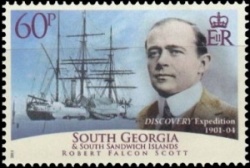
|

|
| Robert Falcon Scott on stamps of South Georgia and the South Sandwich Islands 2011 MiNr.: 543, Scott: 439b | Glossopteris on stamp British Antarctic Territory 1990 MiNr.: 160, Scott: 157 |
Scott and his companions died on the second expedition. When Scott and his party's bodies were discovered, 16kg of Glossopteris (an extinct beech-like tree from 250 million years old) fossils from the Queen Maud Mountains were found next to their bodies, which they had dragged on hand sledges.
These fossils were promised to Marie Stopes (shown on UK stamp in 2008) to provide evidence for Eduard Suess's idea that Antarctica had once been part of an ancient super-continent named Gondwanaland (now Gondwana).
More details are here.
Note: Robert Falcon Scott was honoured on several stamps of British Antarctic Territory and UK, as well as on several international postmarks. [R5]
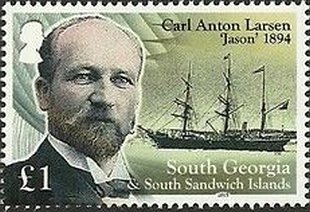 |
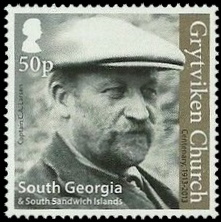 |
| Carl Anton Larsen on stamp of South Georgia and the South Sandwich Islands 2013, 2015 MiNr.: 614, Scott: 493; MiNr.: 646, Scott: 525. | |
[3] On the stamp with the face value of 1GBP shows Carl Anton Larsen.
Carl Anton Larsen (1860 – 1924) was a Norwegian-born whaler, Antarctic explorer, and the pioneer of Antarctic whaling.
He was captain of the Jason on the Norwegian Whaling Exploration, 1892-1893, making a solitary voyage to Antarctic waters from Sandefjord in search of opportunities for whaling.
Landing on Seymour Island, he collected specimens of sedimentary rocks that included fossils of shells and petrified wood, the first recovered from continental Antarctica for which he received the Back Grant from the Royal Geographical Society.
For more details, please click here.
References:
- [R1] South Georgia and the South Sandwich Islands: Wikipedia,
- [R2] Postal History and Philately of South Georgia and the South Sandwich Islands:
Wikipedia,
sgisland.gs,
FPS Limited
Links to official website of the Post Authority, stamp catalog and a list of new stamps of South Georgia and the South Sandwich Islands are here. - [R3] Sir Alister Clavering Hardy: Wikipedia,
- [R4] Aquatic ape hypothesis: Wikipedia, The Conversation,
- [R5] Robert Falcon Scott: Wikipedia, Expeditions fieldmuseum, BBC.
Acknowledgements:
Many thanks to Dr. Peter Voice from Department of Geological and Environmental Sciences, Western Michigan University, for reviewing the draft page and his very valuable comments.
| << previous country | back to index | next country >> |